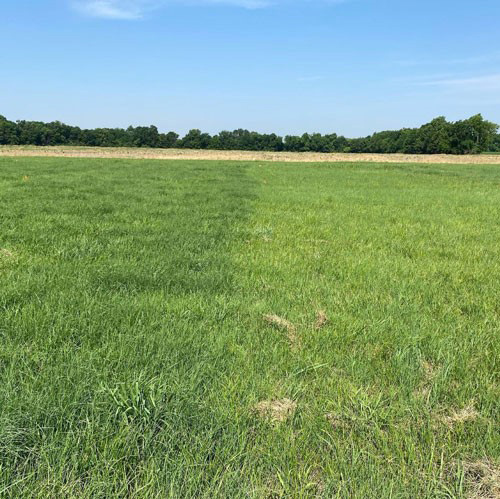Knowing the soil nutrients is a requirement for establishing an adequate soil fertility program for forages. Soil testing can be done in either spring or fall on hayfields and pastures. Given a choice, fall would be the preferred time because it allows more time for any needed lime applications to have an effect before the main growing season begins and gives the producer some flexibility for planning nutrient applications.

Figure 1. Fertility management effect in bermudagrass pastures. The left side of the pasture received an application of nitrogen fertilizer, while the right side did not. Photo credit: K-State Research and Extension.
Soil sampling is typically recommended at least every 3-4 years, but more frequent sampling (every two years) can prevent excessive and unnecessary application of fertilizer or manure and increase yields by revealing exactly which soil nutrients are too low for optimum productivity. This is particularly important during years with high fertilizer prices.
Tips for collecting a representative soil sample
To take accurate soil samples, it is best to use a soil probe. You can borrow a probe from many county Extension or NRCS offices. A shovel or spade can also be used, but make sure to dig a hole first and then take a nice, even slice to the correct depth. A shovel or spade that angles to a point at the bottom can easily result in misleading soil test results because the sample is biased by having more soil from the surface and less from lower depths.
When taking soil samples, it is important to have a representative composite soil sample from the field by combining several soil cores (in a clean container, avoiding contamination) and mixing thoroughly. Ideally, one composite soil sample should represent a uniform and treatable area, not exceeding 40 acres, and no more than 10 acres for more variable fields. In these areas, take 15 to 20 cores or subsamples to make up your representative composite sample. If the field has areas where different forages or crops have been grown or have different soil types, then soil sampling from these areas should be done separately.
For pH evaluation, the sampling depth for pastures and hayfields should be 3 to 4 inches. A 24-inch sample is needed for mobile nutrients, nitrogen, and sulfur. A 6-inch depth is preferred for phosphorus and potassium when submitting samples to the K-State Soil Testing Laboratory since that is the depth we have used to calibrate recommendations.
Soil pH is important
Soil pH is one key soil property for forage production, especially with legumes. The optimal pH level is 6 to 7, depending on the forage species. Grasses such as brome or fescue do well at lower pH than legumes, especially alfalfa, which requires a near-neutral pH (~pH 7). Nutrient uptake can be reduced if the soil pH is too low or too high. The impact of pH on nodulation and nitrogen fixation is especially important for legumes such as alfalfa and clover. At low soil pH, aluminum toxicity can also be an issue.
When you lime a new pasture, it is important to apply the lime 6 to 12 months before planting. If you want to get a more rapid response from liming, use fine-ground liming materials with a high effective calcium carbonate (ECC). Fields that will be planted to alfalfa next spring should also be evaluated for phosphorus and potassium levels and corrections should be made before planting. Sulfur and boron may also be a limiting nutrient for legumes, especially in eastern Kansas.
For more information on soil sampling and submitting samples to the K-State Soil Testing Laboratory, visit their website at http://www.agronomy.k-state.edu/services/soiltesting/. You can also access two previous eUpdate articles discussing fall soil sampling and collecting a representative soil sample in Issue 974, September 14, 2023.
Dorivar Ruiz Diaz, Nutrient Management Specialist
ruizdiaz@ksu.edu
Tina Sullivan, Northeast Area Agronomist
tsullivan@ksu.edu
Tags: soil testing pastures hayfields soil fertility fall soil sampling